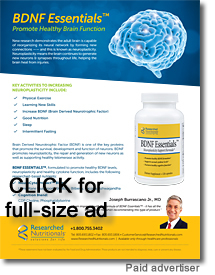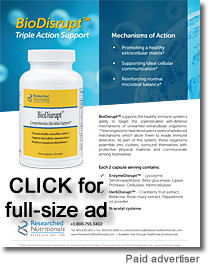|
The multilayered gastro-intestinal (GI) barrier system is very complex and too often under-appreciated. The integrity of the barrier system is essential for prevention of unregulated assimilation of highly antigenic and pro-inflammatory macro-molecules from the lumen of the gut. This article will highlight the components of the highly integrated multi-layered system, and the incredible symbiotic interactions between the GI metabolome and its encompassing and supportive barrier terrain. Important information regarding the integrity of the barrier systems can be gleaned from a truly comprehensive stool analysis report. Indirect and direct assessment of the terrain, and clinical intervention to support the barriers will be addressed.
Like any ecosystem, the GI ecosystem entails a complex network of interactions among and between organisms, and their environment (the barrier system/terrain). The barriers prevent uptake of highly antigenic and pro-inflammatory macromolecules from the lumen of the gut and are also integral to surveillance, protection, and modulation of the GI microbiome. In turn the commensal bacteria facilitate functional integrity of their encompassing terrain. A major component of the GI ecosystem is the GI glycobiome that has been sorely underappreciated. For example, mucins (highly glycosylated proteins) comprise the mucus barrier gradient that provides not only a protective barrier but also regulation of host-pathogen interactions.1
Breaches in the GI barrier systems that potentiate paracellular systemic uptake of macromolecules may be associated with insufficiency dysbiosis, chronic stress, caloric deprivation and low fiber diets, direct adhesion of any bacteria to GI endothelial cells, alcohol/pharmaceuticals/NSAIDS, environmental xenobiotics, inflammation, gluten, an energy dense Western style diet, and excessive exercise with heat stress.2,3 Such breaches may result in systemic inflammation (including neuroinflammation), autoimmunity, food sensitivities, asthma, insulin resistance and behavioral abnormalities.2 The multi-factorial, layered, and highly integrated barrier system is crucial for optimal health and entails far more than the well-appreciated endothelial cell tight junction protein complexes.
 The Multi-Layered Barrier Systems The Multi-Layered Barrier Systems
There are three primary components of the barrier system including the essential commensal bacteria and their metabolites (the GI metabolome).4 Secondly there are the chemical/biochemical components that include cytokines, antimicrobial peptides digestive secretions, sIgA and lysozyme (antimicrobial enzyme); the latter three can be evaluated with comprehensive stool analysis. The final components are the external physical barriers, which include the viscous mucus gradient, the glycocalyx, the endothelial cells (EC) with their tight junctions, and the underlying lamina propria that is enriched with immune cells.
Commensal Bacteria
Insufficiency dysbiosis is often overlooked. Very often clinicians anticipate the presence of dysbiotic microbes in symptomatic patients; the traditional goal is to simply eradicate the "bad dudes" using botanical or pharmaceutical anti-microbial agents. Clinicians are often disappointed when undesirable microbes are not detected and sometimes challenge the competency of the laboratories. Many years ago, Dr. Leo Galand emphasized the fact that insufficient colonization by "beneficial"/commensal bacteria can be associated with GI symptoms and increased permeability that may adversely affect both GI and systemic health. A primary consequence associated with poor status of the beneficial bacterial guilds is diminished production of the short chain fatty acid butyrate that is the master mediator of microbial-host cross talk. Binding to G-protein coupled receptors on specialized cells on/in the GI mucosa,5 butyrate mediates the release of anti-inflammatory cytokines, mucins, hydrogen peroxide, antimicrobial peptides, and lysozyme.6 Butyrate also regulates expression of tight junction proteins between the endothelial cells.7 Therefore adequate constant production of butyrate is essential for maintaining the integrity of the GI barrier system.
Simply providing probiotics is commonly insufficient for remediation of optimal barrier function and aberrant GI permeability. Fiber intake associated with the typical Western diet is dismally low. Provision of adequate fermentable "food" for the bacteria in the form of soluble fiber is of utmost importance. Soluble fiber is not digestible in the upper bowel and is thereby provided to resident commensal bacteria lower in the bowel. There the bacteria saccharolytically ferment the soluble fiber to short-chain fatty acids; butyrate being quintessential.1 Good dietary sources of the soluble fiber include onions, asparagus, leeks, yams, chicory root, agave, bananas, chickpeas, lentils, beans, oatmeal, and vegetables and berries. Starvation (anorexia) and low fiber intake are associated with increased permeability and diminished mucus barrier thickness.
Since some patients do not tolerate dietary fiber well, it would be great to have an effective delivery system that enables supplemental butyrate to reach the lower bowel. It is noteworthy that butyrate is rapidly absorbed and readily crosses the blood brain barrier where it can suppress neuroinflammation.8 The bottom line is that we absolutely must "feed" the commensal bacteria; simply providing high-quality probiotics is futile unless adequate soluble fiber/butyrate is concomitantly provided. When reviewing the results of a truly comprehensive stool analysis, it is very important to note the levels of key commensal bacteria andthe concentration of fecal butyrate.
Clostridium Species – Unduly Unappreciated
"Clostridiaphobia" is widespread. The five toxigenic Clostridium species, such as C. difficile, have instilled undue concern about the normal presence of the approximately 100 non-toxigenic Clostridium species. Commensal Clostridia are major butyrate producers that facilitate microbial-host cross talk that is paramount to GI barrier integrity.9 Decreased abundance of Clostridium species has been reported for patients with colorectal cancer and inflammatory bowel disease.10 It should be noted that in addition to Bifidobacterium, commensal Clostridium species are vertically transferred from the maternal microbiome into mom's lymph and breast milk with colonization in the bowels of breastfed infants during the first month of life.11 The mechanism for that transfer of maternal bacteria involves the long extended "feet" of dendritic cells that reach up through pores in specialized M cells in the mucosa. An increased abundance of commensal Clostridium species is associated with high fiber intake from fruit, vegetables, beans, and chickpeas (raffinose).9
A result of 3-4+ for Clostridium species (anaerobic cultivation) should not necessarily invoke clinical concern. Only when patients present with multiple daily bouts of profuse watery diarrhea should additional testing for potential toxin producing C. difficile be considered. Unnecessary antibiotic treatment of asymptomatic C. difficile carriers has resulted in near complete antibiotic resistance.12 High-sensitivity molecular testing for toxin-producing C. difficile is available for use on anaerobically cultivated C. difficile or directly on a stool specimen.
Mucins and the Mucus "Blanket"
Mucins are highly glycosylated proteoglycans produced by goblet cells in the mucosa; the protective mucins are constantly reshaped and refreshed.1 There are cell-bound and secretory mucins. The cell-tethered mucins, along with lipids, form a viscous protective gel layer (glycocalyx) atop the apical surface of the mucosa. They prevent direct binding of any bacteria, even commensals, to endothelial cells. Mucins are protective to endothelial cells as biofilm is to bacteria and yeast. Above the glycocalyx is an inner dense, loosely associated mucus blanket that is prime real estate that harbors sIgA, antimicrobial peptides, and reactive oxygen species.4 Proteolytic activity of the mucins decreases the density of the mucus blanket as it extends up towards the lumen. The less dense upper mucus layer provides a "loose river" that facilitates passage of pathogens via normal peristalsis. GI goblet cells produce about 5 liters of mucus each day, and they also deliver antigens to associated dendritic cells in the lamina propria. Signaling from the associated detrocytes induces abrupt release of more mucus-forming mucins.4 Mucus production is regulated by butyrate released from commensal bacteria.
The importance of the mucus barrier system is emphasized by the fact that patients with ulcerative colitis tend to have less commensal bacteria, thinner mucus barriers, increased colonization of pathogens, and increased GI permeability.13 Obesity and high-saturated fat intakes are also associated with decreased mucus thickness and increased GI inflammation and permeability.14 Juxtaposed, prebiotics (oligosaccharides/soluble fiber) increase mucin-stimulating bacteria and butyrate production. The importance of adequate dietary intake of soluble fiber cannot be over emphasized.
Secretory IgA (sIgA) – Constant Surveillance, Sampling, and Communication
Secretory IgA in the gut is the major first line of defense by the humoral immune system.15 sIgA is a "brick" in the mucus barrier. It is anchored in the inner dense mucus layer and on the surface of endothelial cells where it provides immune exclusion of microbes (including specific viruses) and enterotoxins.4 When sIgA binds to pathogenic microbes, it alters their membrane potential and decreases their ability to produce energy. That diminishes the pathogens motility and ability to produce self-protective biofilm. sIgA also facilitates antiparasitic activity of eosinophils and has anti-inflammatory activity in that it suppresses NF-ҡB-induced proinflammatory cytokines.
Increased fecal sIgA is an appropriate immune response to enteropathogens, and fecal levels may remain elevated up to six weeks after a specific GI virus. It is not normal to have non-detectable or very low levels of fecal sIgA. It regulates the composition of the microbiota by providing constant surveillance, sampling and communication with immune cells.16 Major Candida overgrowth may be associated with low fecal sIgA because it has been reported that 38 species of Candida isolated from patients expressed sIgA -specific protease activity.17 Chronic stress (high cortisol, low DHEA) is also associated with low levels fecal sIgA.18 Intervention for low sIgA includes omega-3 fatty acids, zinc, vitamins D and A, S. boulardii, L. rhamnosus GG, Bifidobacterium lactis Bb-12, prebiotics (butyrate), and glutamine.19,20 An appropriate level of sIgA in the gut is a critical barrier constituent in the maintenance of a healthy microbiome.
GI Epithelial Cells – The Final Barrier
When the supra endothelial barriers structure/function is compromised, dysbiotic microbes and antigenic/pro-inflammatory macromolecules have a much greater chance of breaching the GI endothelial cell (EC) barrier by means of unregulated paracellular influx. Zonulin, a protein produced and released from the EC, is currently the only known physiological reversible regulator of the EC tight junction protein complexes (TJP).21,22 Sustained release of zonulin that result in elevations in serum zonulin (antigen) is causally associated with proteolytic breakdown of the TJP. Such occurs consequentially with autoimmune diseases (celiac, Crohn's, RA, T1DM), some cancers, neurological conditions (demyelinating polyneuropathy, MS), obesity, juvenile non-alcoholic fatty liver disease, asthma, metabolic syndrome, and even non-celiac gluten sensitivity.7,23-29
 Some triggers for excessive release of zonulin include gliadin, inflammation, direct adherence of any bacteria to EC, excessive LPS, bacterial enterotoxins, excessive fructose, and possibly some industrial food additives.30 Some of the suspect food additives include emulsifiers, microbial transglutaminase ("meat glue"), and nanoparticles. Elevated serum zonulin (antigen) levels are highly correlated with high urinary ratios of lactulose to mannitol (L:M); both are indicative of paracellular epithelial permeability. To date we have seen similar rates of positivity for high serum zonulin (14.5%) and high L:M (15%) in specimens from patients; that challenges the popular suggestion that "we all have intestinal permeability" to a sustained clinically significant extent. Based upon the results of lactulose:mannitol load testing in healthy adults (n=47), it has been suggested that the reliability of the "gold standard" test of intestinal permeability is improved when urine is collected between 2.5 and 4 hours as opposed to the traditional six-hour collection.30 Some triggers for excessive release of zonulin include gliadin, inflammation, direct adherence of any bacteria to EC, excessive LPS, bacterial enterotoxins, excessive fructose, and possibly some industrial food additives.30 Some of the suspect food additives include emulsifiers, microbial transglutaminase ("meat glue"), and nanoparticles. Elevated serum zonulin (antigen) levels are highly correlated with high urinary ratios of lactulose to mannitol (L:M); both are indicative of paracellular epithelial permeability. To date we have seen similar rates of positivity for high serum zonulin (14.5%) and high L:M (15%) in specimens from patients; that challenges the popular suggestion that "we all have intestinal permeability" to a sustained clinically significant extent. Based upon the results of lactulose:mannitol load testing in healthy adults (n=47), it has been suggested that the reliability of the "gold standard" test of intestinal permeability is improved when urine is collected between 2.5 and 4 hours as opposed to the traditional six-hour collection.30
Clinical intervention to restore the EC barrier entails first removing the trigger(s) for excessive zonulin release. Documented supports for then increasing the expression of the tight junction proteins include specific probiotics and prebiotics (11 grams inulin/day),31 curcumin, quercetin, vitamin D and retinol, and γ-linoleic acid.2,4 Chitosan and ethanol consequentially decrease the expression of the tight junction proteins.32
In summary, clinically important information can be gleaned from a truly comprehensive stool analysis regarding the highly integrated, multi-factorial GI barrier system. Do consider the aforementioned consequences of insufficiency dysbiosis for symptomatic patients even in the absence of dysbiotic microbes. Factor in low levels of butyrate (absolute), sIgA, high levels of inflammatory proteins (e.g. lysozyme, calprotectin, lactoferrin), and mucus (shedding) in stool specimens. GI permeability of the epithelial cell barrier is indicated by elevated levels of serum zonulin or urinary lactulose: mannitol. A broader appreciation of the entirety of the GI barrier system may improve clinical success and patient satisfaction.
 References .pdf References .pdf
David Quig, PhD, received his BS and MS degrees in human nutrition from Virginia Tech and a PhD in nutritional biochemistry from the University of Illinois. After a five-year stint as a research associate studying lipid biochemistry and cardiovascular disease at Cornell University, he worked as a senior cardiovascular pharmacologist for seven years with a major pharmaceutical company. For the past 22 years, David has served as the Vice President of Scientific Support for Doctor's Data, Inc. He has focused on toxic metals, methylation and amino acid metabolism, the clinical application of the biochemistry of endogenous detoxification, and the influence of the gastrointestinal metabolome on health and sustained adverse conditions. David regularly speaks at national and international medical conferences and has facilitated and co-authored an array of studies, spanning exposure and retention of environmental toxicants, nutritional status, and gastrointestinal dysbiosis.
|
![]()
![]()








